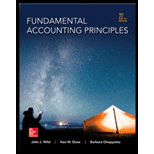
Fundamental Accounting Principles -Hardcover
22nd Edition
ISBN: 9780077862275
Author: John J Wild, Ken Shaw Accounting Professor, Barbara Chiappetta Fundamental Accounting Principles
Publisher: McGraw-Hill Education
expand_more
expand_more
format_list_bulleted
Concept explainers
Textbook Question
Chapter 11, Problem 1QS
Classifying liabilities
C1
Which of the following items are normally classified as current liabilities for a company that has a 15-month operating cycle?
______1. Portion of long-term note due in 15 months.
______2. Note payable maturing in 2 years.
______3. Note payable due in 18 months.
______4. Note payable due in 11 months.
______5. FICA taxes payable.
______6. Salaries payable.
Expert Solution & Answer
Want to see the full answer?
Check out a sample textbook solution
Students have asked these similar questions
Aerotrino produces and sells popular t-shirts. Following is information about
its t-shirts for 2014:
Selling price $15.00 per
t-shirt
Variable costs:
Production (manufacturing costs) - $3.50
per t-shirt
Selling & administration -
$1.00 per t-shirt
Fixed costs:
Production (manufacturing costs) - $1,000,000 per year
Selling & administration - $2,000,000 per year
During 2014, the company produced 400,000 t-shirts and sold 350,000 of
them. Assume that there was no beginning inventory. How much is the net
income under variable costing?
ROE?
ANSWER THIS GENERAL ACCOUNTING PROBLEM
Chapter 11 Solutions
Fundamental Accounting Principles -Hardcover
Ch. 11 - Prob. 1DQCh. 11 - Prob. 2DQCh. 11 - What are the three important questions concerning...Ch. 11 - Prob. 4DQCh. 11 - Prob. 5DQCh. 11 - Prob. 6DQCh. 11 - Prob. 7DQCh. 11 - Prob. 8DQCh. 11 - Prob. 9DQCh. 11 - Prob. 10DQ
Ch. 11 - Prob. 11DQCh. 11 - Prob. 12DQCh. 11 - Prob. 13DQCh. 11 - Prob. 14DQCh. 11 - Prob. 15DQCh. 11 - Prob. 16DQCh. 11 - Prob. 17DQCh. 11 - Classifying liabilities C1 Which of the following...Ch. 11 - Prob. 2QSCh. 11 - Prob. 3QSCh. 11 - Prob. 4QSCh. 11 - Prob. 5QSCh. 11 - Prob. 6QSCh. 11 - Prob. 7QSCh. 11 - Prob. 8QSCh. 11 - Prob. 9QSCh. 11 - Prob. 10QSCh. 11 - Prob. 11QSCh. 11 - Prob. 12QSCh. 11 - Prob. 13QSCh. 11 - Prob. 14QSCh. 11 - Prob. 1ECh. 11 - Prob. 2ECh. 11 - Prob. 3ECh. 11 - Prob. 4ECh. 11 - Prob. 5ECh. 11 - Prob. 6ECh. 11 - Prob. 7ECh. 11 - Prob. 8ECh. 11 - Prob. 9ECh. 11 -
Hitzu Co. sold a copier costing S4.800 with a...Ch. 11 - Prob. 11ECh. 11 - Prob. 12ECh. 11 - Prob. 13ECh. 11 - Prob. 14ECh. 11 - Prob. 15ECh. 11 - Prob. 16ECh. 11 - Prob. 17ECh. 11 - Prob. 18ECh. 11 - Prob. 1APSACh. 11 - Prob. 2APSACh. 11 - Prob. 3APSACh. 11 - Prob. 4APSACh. 11 - Prob. 5APSACh. 11 - Prob. 6APSACh. 11 - Problem 11-1B Short-term notes payable...Ch. 11 - Prob. 2BPSBCh. 11 - Prob. 3BPSBCh. 11 - Prob. 4BPSBCh. 11 - Prob. 5BPSBCh. 11 - Prob. 6BPSBCh. 11 - Prob. 11SPCh. 11 - Prob. 11CPCh. 11 - Prob. 1GLPCh. 11 - Prob. 1BTNCh. 11 - Prob. 2BTNCh. 11 - Prob. 3BTNCh. 11 - Prob. 4BTNCh. 11 - Prob. 5BTNCh. 11 - Prob. 6BTNCh. 11 - Prob. 7BTNCh. 11 - Prob. 8BTNCh. 11 - Prob. 9BTN
Knowledge Booster
Learn more about
Need a deep-dive on the concept behind this application? Look no further. Learn more about this topic, accounting and related others by exploring similar questions and additional content below.Similar questions
arrow_back_ios
SEE MORE QUESTIONS
arrow_forward_ios
Recommended textbooks for you
- Principles of Accounting Volume 1AccountingISBN:9781947172685Author:OpenStaxPublisher:OpenStax College

Principles of Accounting Volume 1
Accounting
ISBN:9781947172685
Author:OpenStax
Publisher:OpenStax College
Chapter 19 Accounting for Income Taxes Part 1; Author: Vicki Stewart;https://www.youtube.com/watch?v=FMjwcdZhLoE;License: Standard Youtube License